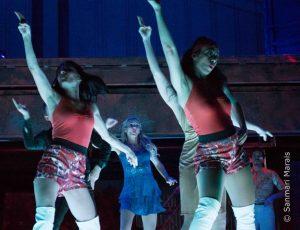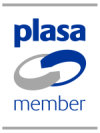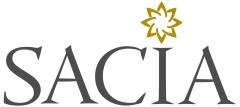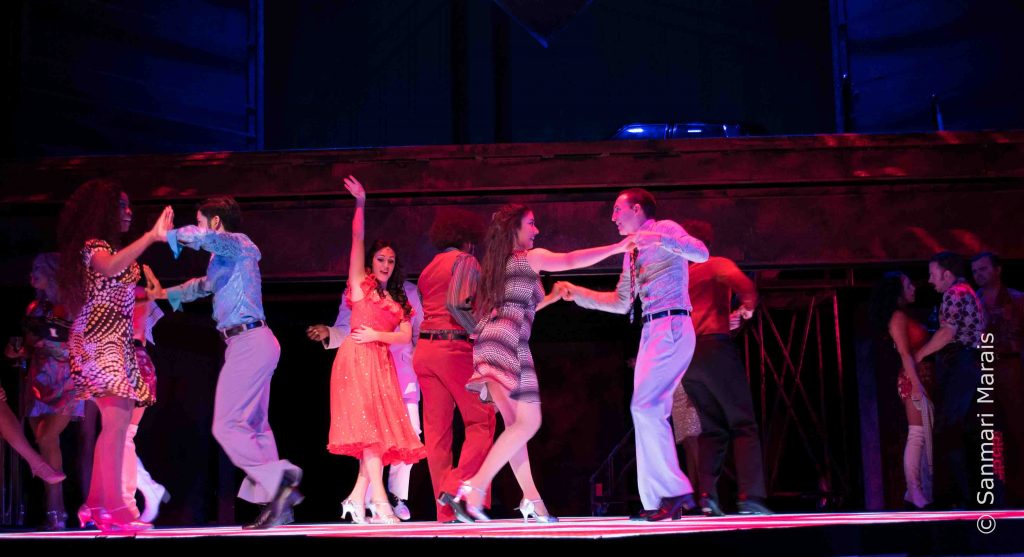
Saturday Night Fever is a breath of fresh air at the Pretoria State Theatre, combining a dazzling all South African cast and a brilliant technical team. Denis Hutchinson is the lighting and set designer of this classic production which left the audience entertained and smiling. The show runs till 9th October so be sure to book your space while you can. Words by Denis Hutchinson (Hutch).
For the first time in South Africa, the Saturday Night Fever script was released where the creatives did not have to follow the formulae of the original production while obviously still serving the piece. The difficulty with the Saturday Night Fever musical script is that they’ve taken the movie script and each time it says ‘cut to’ they have just tipp-exed that out. Of course in a movie it’s very easy to ‘cut to’ but on stage you physically have to move things and people around, so half of the challenge was trying to keep it flowing realistically while making all the changes. I’m pleased that there’s no point where the scenery holds the show up and in some places we have more scene change music than we need, which is always a good sign.
An iconic feature of the movie is the famous image of John Travolta posing on the lit floor. The movie’s disco scenes were shot at a club in Brooklyn called 2001 Odyssey, the reason being that the club had an amazing dance floor that lit up. Bearing in mind the piece is set in 1977 and moving lights would only come out four years later with the arrival of the Vari-Lite VL1 in September 1981, the average disco at that time would have had a dozen Par38s in red, yellow and blue, a couple of black light tubes, if you were lucky a strobe, and probably a couple of pin spots and a mirror ball. The 2001 Odyssey had all of that but they also had this floor which was basically 320 light boxes, each with a single light bulb inside. Each box could light up or not light up and there was no colour change. Some boxes had red bulbs, some had white and some had blue, in a pattern. It was three circuits. You could have the reds on, the blues on, the whites on or all on. That was it!
To do the theatrical show without the floor, well you’re not going to get away with it! The audience expect it. Obviously we have moved on from a technology point of view and to do the floor the way it was done originally would be insanely expensive with a lot of unnecessary hard work. So although I’ve tried to make the floor look like the original we’re using LED technology so we actually have an LED dancefloor which in its normal format would project images and run videos and all sorts of things, but that would be inappropriate for 1977, so we are doing it in a much simpler way.
Because the floor requires a DVI input we are actually putting video out even if it doesn’t appear to be living, breathing, moving video. We are running a series of masks using grandMA 2 light to control an ArKaos media server. We use six different layers on ArKaos and then from the grandMA I can change effectively the “gobos” which as a result changes the floor pattern, and I can change the colours of the layers. Thank you to Bruce Riley and Nick Britz from DWR who spent a lot of time making it all work. I spent a couple of days in the demo room at DWR just playing with the system, writing some chases and things like that. It was a nice learning curve because I had used an early version of ArKaos years ago so it was good to see the latest version and to be able to integrate it with the desk in the way we did.
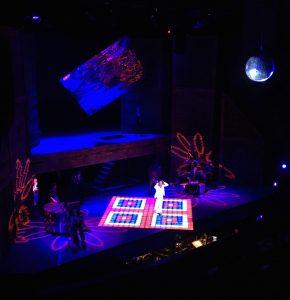
In the first disco scene on stage the floor takes the exact pattern and colour of the floor in the movie, doing only what the movie floor could do. So there’s a bit of homage to the floor in the first scene but if one stuck to only doing what the floor could do originally, a contemporary audience will get slightly bored because they are used to so much more. Consequently, I do cheat. The first disco sequence I don’t change the pattern at all but I do cheat with colour a little bit. The second disco sequence I start cheating with pattern and colour, and by the final I’m doing all of the above.
The nature of disco lighting was lots of flashing lights and there’s nothing more irritating than lights that are flashing off the beat. So the other thing we wanted to do was integrate with the orchestra and obviously when you have a live orchestra it’s not quite the same thing as when everything is on tracks. However, most of the disco numbers do have click track so we are feeding that into the GrandMA and linking it to a rate fader which is working very well.
I have been disciplined about not using moving lights. There are moving lights lighting the scenes but they’re never seen to move because they weren’t actually in existence at that time. Although the average audience does not know or care about that, for me a little bit of historical accuracy helps evoke the period. The disco scenes, lighting wise, are quite simple but they’re also quite difficult because with every disco scene, besides having the disco elements and the dancing, there are also book scenes being played where people have to be able to hear and understand the dialogue. It’s a very delicate balance between keeping the sense and feel of disco and still directing focus to where it should be and basically having a degree of visibility that never existed in those clubs. If you think of the average disco, maybe not so much today but certainly then, you could barely see the person you were dancing with. They were black boxes with minimal lights which is why you didn’t see how dirty they were! So it has been interesting to get the balance right so that it feels dark but you can still see what the dancers are doing, you can still see and hear what’s happening in the scenes and there is some kind of focus as to where you should be looking. It’s a balance an audience shouldn’t notice, but if you get it wrong the scenes won’t play properly. That was fun too.
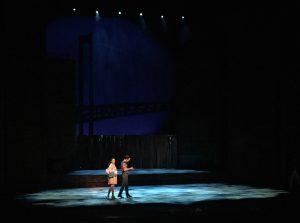
One of the interesting things about lighting for the theatre as opposed to other forms of lighting, is that lighting in a theatre has all the normal lighting functions but it also functions as editing does in a film. By the way you light different moments you can focus the audience’s attention, which is the same as choosing the shot. Also the way you go from shot to shot, whether you do it as gentle cross fades, snap cross fades or however you do it, effects the pacing in much the same way that editing of film affects the pacing. A lot of jump cuts does one thing, very clean cuts does another thing, dissolves something else. We all inherently understand the language of film even though most of us have never actually had it explained to us. So for me one of the most interesting parts of lighting for a theatre is that you are playing with where the audience look and when they look. You are often concealing as much as you’re revealing. It’s the old magic trick, make them look here when you want to hide something over there. That for me is far more interesting than just lights for lights sake.
With a lot of scenery, hanging positions for lights are restricted by what scenery is in the air. When a particular piece of scenery is in use, it may mean that certain lights can’t be used because they’re behind that piece of scenery. Lighting a musical becomes quite a complex operation because there are no two moments in a show where you can use the same lights in quite the same way. So you have to factor all of that into your design. If you don’t work it through very carefully on paper in advance you can end up with a whole bunch of lights that you can never use – a waste of time and energy.
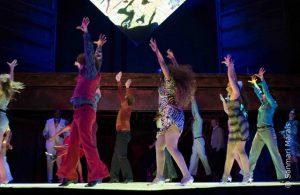
This musical is particularly tricky in that respect because we wanted to pull the show as far forward as possible because it needs a degree of intimacy and the State Theatre is a big venue. Most importantly there’s this huge orchestra pit which is designed for an 80-piece orchestra. Saturday Night Fever is a ten piece. I’ve cantilevered the whole show out over the orchestra so we have a tiny pit that’s appropriate for a ten piece and the show is as close to the audience as possible. But when you do that you create a situation where you can’t fly anything over a vast area of the stage because it’s in front of the proscenium. At the State Theatre because of various things that have happened historically there’s not a lot of flying between the proscenium and the start of lift 1 either. In fact, there are only four bars in the entire space. So by the time you’ve got a show cloth, a header and a mirror which requires two bars there’s nothing left to hang lights of in that area. So I’ve had to hang a certain amount of trussing in order to have lights in there but because there’s a mirror that flies in three dimensions you can’t hang lights just anywhere and I’ve ended up with one 2m section of truss each side of the mirror with four lamps on each with the next lighting position some 2m further upstage where there is only room for twelve lamps!
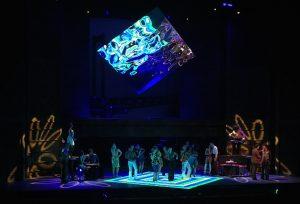
The deal was that I had to use the equipment that the State Theatre has and I had a very small budget over and above that. The bulk of their rig is old ADB 2kW fresnels and PCs with some newer SPX and Pacifics but they do now have 12 x Robe MMX Spots, 16 x Robin 600 LEDWash and 20 x Robe LEDForce Pars. I’ve augmented that with 4 x Philips Vari-Lite VL 3000 Spots, 2 x VL 3500 Spots and 4 x ETC Source Four LED Lustr+ MkIIs. For various reasons I’ve used virtually none of the generic rig other than Front of House and by musical standards its actually quite a small rig. Actually there are several other musicals running in South Africa at the moment on smaller stages with more lights but you know the old story, the right light at the right place at the right time; it’s not how many lights you have but how you use them and I’ve deliberately downplayed some of what the equipment that I have can do because it’s not appropriate to the period of the piece.
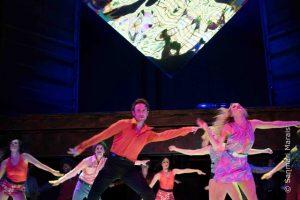
Although it’s a modern production you don’t want to swamp the period feel of 1977 with stuff that wasn’t actually possible. So the movers move a lot during the course of the show but you never see them move because these type of fixtures didn’t exist back then. Because of modern colour change techniques there’s a much broader range of colour than what would have been possible back then but it’s never an overt additional use. There are some parcans that I use in the disco scenes and the choice of colours is very deliberate because I remember from those days you had these dreadful par 38s which were ink dyed so the colour used to fade and you had bits of white sticking through and the blue was really green, it wasn’t a real blue and the yellow was a horrible yellow. I’ve deliberately looked for the closest matches I could find to those colours. Its more for people my age and older who were actually going to discos at the time and for them to say, “Well I remember dancing under that horrible colour”. I think for the older part of the audience there’s an enormous amount nostalgia and you want to evoke something to get all the nostalgic juices going and at the same time do things that are hopefully interesting for a contemporary (younger) audience. So for me it was a really stimulating design project in terms of balancing authenticity with not boring a modern audience.
The truth is if you’re not a little bit scared as a lighting designer when working on a show like this then you haven’t done your job and its indicative of the fact that either you don’t know what you are doing or that you’ve fallen back on habits and reduced everything to formulae. If you do that you might get away with it but it’s going to be dreary. If you are not quite sure it’s going to work then you’ve pressed the envelope a little bit in some way and I think that’s important. People make the mistake of thinking when you press the envelope its always something radical, extraordinary. It’s not always. Sometimes it’s quite a delicate pressing of the envelope. But if it still achieves the results, that’s the important thing. The fact that I couldn’t hang lights where I wanted them because it’s not physically possible was pretty scary. At the same time though, if I’d gone the easy route and moved the whole show three meters upstage which would have solved most of the lighting problems the show would have been 3m further away from the audience. That’s not good. So ironically if I hadn’t been lighting the show I might have been more inclined to push it further back to give the lighting designer a chance but because I was lighting the show, to hell with it!
